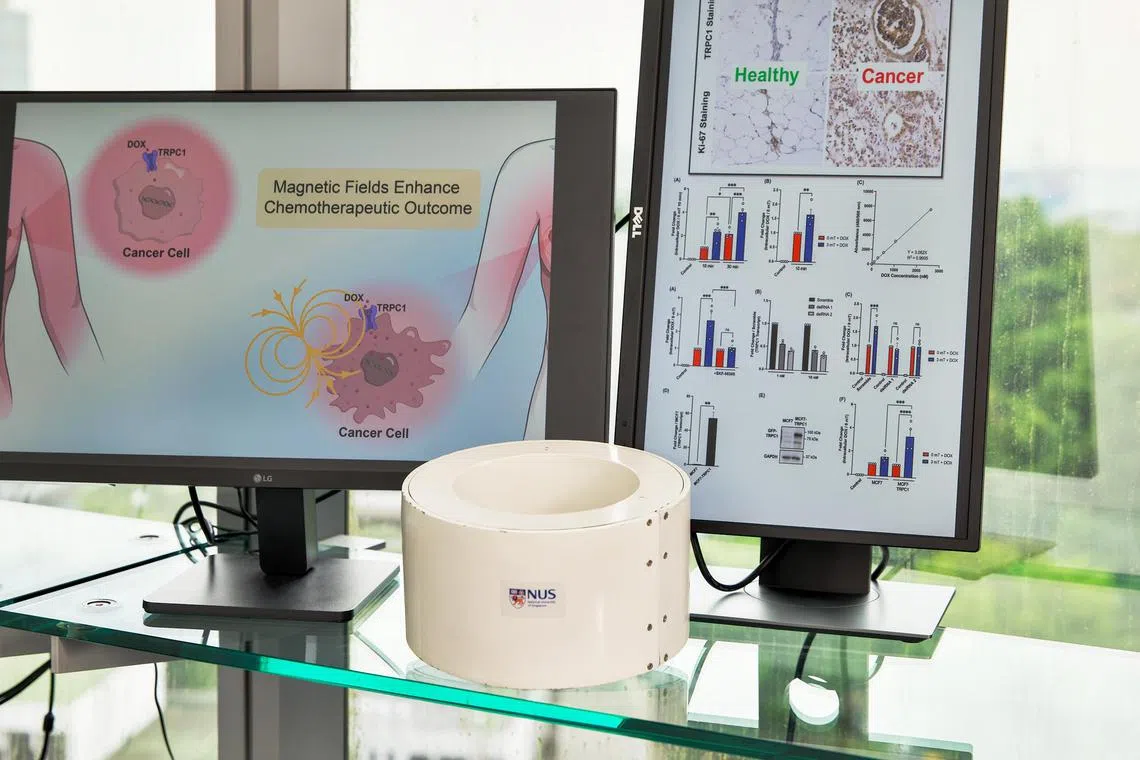Magnetic pulses boost breast cancer chemo, potentially reducing side effects: NUS study
Sign up now: Get ST's newsletters delivered to your inbox

(From left) Dr Alex Tai, Associate Professor Alfredo Franco-Obregon and Mr Viresh Krishnan Sukumar developed a therapy that potentially enhances the effectiveness of chemotherapy for breast cancer.
PHOTO: NUS INSTITUTE FOR HEALTH INNOVATION & TECHNOLOGY
Follow topic:
SINGAPORE – Researchers from the National University of Singapore (NUS) have found that non-invasive magnetic pulses can enhance the effectiveness of chemotherapy for breast cancer, and potentially reduce side effects for patients.
The use of brief, targeted magnetic pulses on cancer cells can increase their absorption of the widely used chemotherapy drug doxorubicin.
With more of the drug entering the tumour to shrink it, less doxorubicin needs to be administered to the patient from the onset, thus reducing the often debilitating side effects of chemotherapy, said Associate Professor Alfredo Franco-Obregon, principal investigator at the NUS Institute for Health Innovation and Technology.
A 10-minute magnetic field exposure in the laboratory also reduces the concentration of the chemotherapy drug required by half.
“What’s promising is that this mechanism works strongest at low drug concentrations, enabling us to target cancer cells more effectively while reducing the burden of chemotherapy on healthy tissues,” said Prof Franco-Obregon.
While this method has been proven in the lab, Assistant Professor Joline Lim of the National University Cancer Institute, Singapore – who is also part of the research team – hopes to conduct more clinical studies to determine if these findings apply to the human body.
“The promising (pre-clinical) results have led to great interest to investigate if magnetic field therapy can be safely used for breast cancer patients, and if so, if it can then be combined with chemotherapy to boost its effectiveness to improve patient response to treatment,” said Prof Lim, a senior consultant at the Department of Haematology-Oncology.
In the body, chemo drugs often cannot distinguish between cancerous cells and healthy ones, and it is the damage to healthy cells that causes side effects such as hair loss, vomiting, fatigue and muscle loss.
“Chemotherapy, although it’s very important in killing cancer... also kills the organism. So it’s a little bit too good at its job,” said Prof Franco-Obregon.
Breast cancer cells have elevated levels of a protein called TRPC1, which acts as the gateway for the chemo drug. Magnetic field exposure activates the protein, essentially allowing it to widen a cancer cell’s “gate” to allow more of the drug to enter.
When this combined therapy was done on healthy muscle cells, the normal tissues were not targeted as much, with no increase in cell death.
The team’s research was published in the scientific journal Cancers in November 2024.
Since 2023, the magnetic therapy device – which includes a short, hollow cylinder that produces magnetic pulses – has been used on more than 10 breast cancer patients at the National University Cancer Institute as part of early-phase trials to ensure the therapy is safe.
For a start, the patients were given just the magnetic therapy.
So far, no adverse effects have been seen in patients with advanced cancer and those undergoing surgery, with no compromise on wound healing, said Prof Franco-Obregon.

The magnetic therapy device includes a short, hollow cylinder (centre) that produces a pulsed magnetic field similar in strength to what a hairdryer produces.
PHOTO: NUS INSTITUTE FOR HEALTH INNOVATION AND TECHNOLOGY
Recently, some patients involved in the study received one cycle of chemo with the magnetic therapy.
During treatment, the patient lies face down on a bed that has an opening for the chest region. The magnetic device is placed below the opening.
Once the device is turned on, a pulsed magnetic field – similar in strength to what a hairdryer produces – is emitted to the tumour and cancer cells for 30 minutes. Afterwards, a dose of the chemo drug is given to the patient intravenously.
If this combined therapy for one cycle is proven to be safe, it will be extended to the entire course of chemotherapy – comprising several cycles – for future participants.
This constitutes the next step in finding out if the magnetic therapy can truly boost chemotherapy’s ability in killing and shrinking breast tumours, said Prof Lim.
Breast cancer is the most common type of cancer among women in Singapore, with one in 13 women likely to be afflicted, according to SingHealth.
Commenting on the research, Assistant Professor Andrea Pavesi from the NTU Lee Kong Chian School of Medicine said there is potential and significance in harnessing physical forces such as magnetism and electricity to enhance cancer therapies.
Prof Pavesi, who specialises in cancer biology, previously worked on a technique that uses low-energy electrical fields to disrupt the ability of cancer cells to grow and divide.
“Ultimately, defeating tumours necessitates parallel research in multiple directions and a wide variety of tailored treatment strategies to achieve the best outcomes for patients,” he added.
The NUS cancer study builds on a more established technology that Prof Franco-Obregon and his team have devised to help frail seniors strengthen their muscles, and athletes recover faster from injury.
In 2021, his team rolled out a hollow machine called Bixeps
As at December 2024, seniors at about 30 care centres here have access to the Bixeps machines.
In January 2025, Bixeps’ sister machine – targeted for use in hospitals – was cleared by the US Food and Drug Administration.
Correction note: The story has been edited for clarity.


